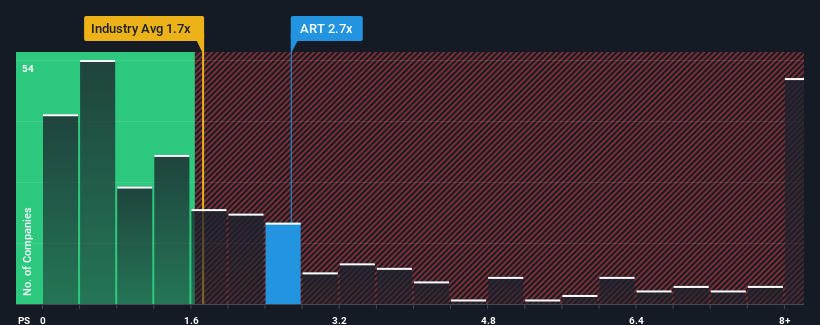The Airtasker Limited (ASX:ART) share price has softened a substantial 26% over the previous 30 days, handing back much of the gains the stock has made lately. Looking at the bigger picture, even after this poor month the stock is up 35% in the last year.
Even after such a large drop in price, there still wouldn’t be many who think Airtasker’s price-to-sales (or “P/S”) ratio of 2.7x is worth a mention when the median P/S in Australia’s Interactive Media and Services industry is similar at about 2.4x. Although, it’s not wise to simply ignore the P/S without explanation as investors may be disregarding a distinct opportunity or a costly mistake.
Check out our latest analysis for Airtasker

What Does Airtasker’s P/S Mean For Shareholders?
With revenue growth that’s inferior to most other companies of late, Airtasker has been relatively sluggish. One possibility is that the P/S ratio is moderate because investors think this lacklustre revenue performance will turn around. However, if this isn’t the case, investors might get caught out paying too much for the stock.
Keen to find out how analysts think Airtasker’s future stacks up against the industry? In that case, our free report is a great place to start.
What Are Revenue Growth Metrics Telling Us About The P/S?
Airtasker’s P/S ratio would be typical for a company that’s only expected to deliver moderate growth, and importantly, perform in line with the industry.
Retrospectively, the last year delivered an exceptional 16% gain to the company’s top line. The latest three year period has also seen an excellent 103% overall rise in revenue, aided by its short-term performance. Accordingly, shareholders would have definitely welcomed those medium-term rates of revenue growth.
Turning to the outlook, the next three years should generate growth of 13% per annum as estimated by the three analysts watching the company. That’s shaping up to be materially higher than the 7.8% per annum growth forecast for the broader industry.
With this in consideration, we find it intriguing that Airtasker’s P/S is closely matching its industry peers. Apparently some shareholders are skeptical of the forecasts and have been accepting lower selling prices.
The Bottom Line On Airtasker’s P/S
Airtasker’s plummeting stock price has brought its P/S back to a similar region as the rest of the industry. Using the price-to-sales ratio alone to determine if you should sell your stock isn’t sensible, however it can be a practical guide to the company’s future prospects.
Looking at Airtasker’s analyst forecasts revealed that its superior revenue outlook isn’t giving the boost to its P/S that we would’ve expected. There could be some risks that the market is pricing in, which is preventing the P/S ratio from matching the positive outlook. It appears some are indeed anticipating revenue instability, because these conditions should normally provide a boost to the share price.
Plus, you should also learn about this 1 warning sign we’ve spotted with Airtasker.
Of course, profitable companies with a history of great earnings growth are generally safer bets. So you may wish to see this free collection of other companies that have reasonable P/E ratios and have grown earnings strongly.
New: Manage All Your Stock Portfolios in One Place
We’ve created the ultimate portfolio companion for stock investors, and it’s free.
• Connect an unlimited number of Portfolios and see your total in one currency
• Be alerted to new Warning Signs or Risks via email or mobile
• Track the Fair Value of your stocks
Have feedback on this article? Concerned about the content? Get in touch with us directly. Alternatively, email editorial-team (at) simplywallst.com.
This article by Simply Wall St is general in nature. We provide commentary based on historical data and analyst forecasts only using an unbiased methodology and our articles are not intended to be financial advice. It does not constitute a recommendation to buy or sell any stock, and does not take account of your objectives, or your financial situation. We aim to bring you long-term focused analysis driven by fundamental data. Note that our analysis may not factor in the latest price-sensitive company announcements or qualitative material. Simply Wall St has no position in any stocks mentioned.

